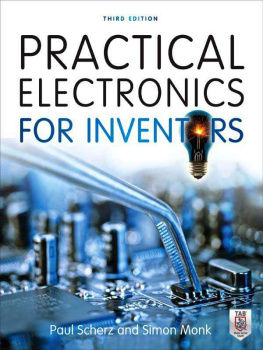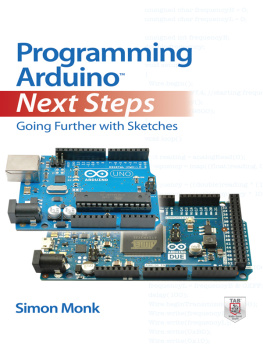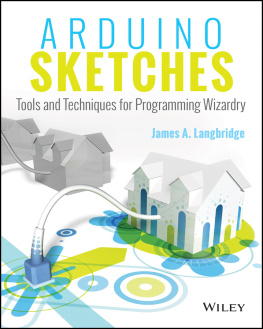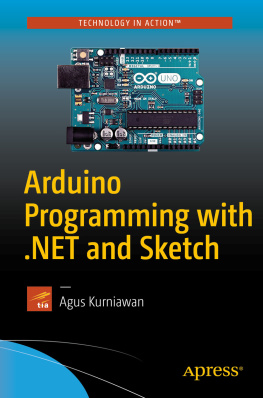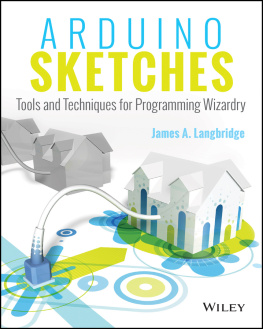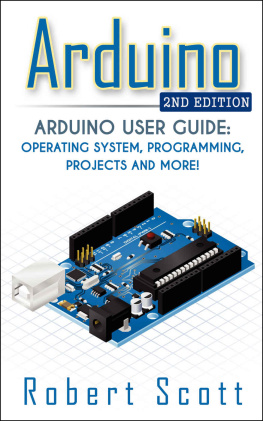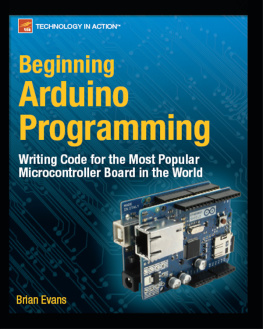Programming Arduino
Getting Started with Sketches
Simon Monk
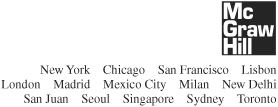

Copyright 2012 by The McGraw-Hill Companies. All rights reserved. Except as permitted under the United States Copyright Act of 1976, no part of this publication may be reproduced or distributed in any form or by any means, or stored in a database or retrieval system, without the prior written permission of the publisher.
ISBN: 978-0-07-178423-8
MHID: 0-07-178423-3
The material in this eBook also appears in the print version of this title: ISBN: 978-0-07-178422-1, MHID: 0-07-178422-5.
All trademarks are trademarks of their respective owners. Rather than put a trademark symbol after every occurrence of a trademarked name, we use names in an editorial fashion only, and to the benefit of the trademark owner, with no intention of infringement of the trademark. Where such designations appear in this book, they have been printed with initial caps.
McGraw-Hill eBooks are available at special quantity discounts to use as premiums and sales promotions, or for use in corporate training programs. To contact a representative please e-mail us at bulksales@mcgraw-hill.com.
All trademarks or copyrights mentioned herein are the possession of their respec-tive owners and McGraw-Hill makes no claim of ownership by the mention of products that contain these marks.
Arduino is a trademark of the Arduino team.
Information has been obtained by McGraw-Hill from sources believed to be reliable. However, because of the possibility of human or mechanical error by our sources, McGraw-Hill, or others, McGraw-Hill does not guarantee the accuracy, adequacy, or completeness of any information and is not responsible for any errors or omissions or the results obtained from the use of such information.
TERMS OF USE
This is a copyrighted work and The McGraw-Hill Companies, Inc. (McGraw-Hill) and its licensors reserve all rights in and to the work. Use of this work is subject to these terms. Except as permitted under the Copyright Act of 1976 and the right to store and retrieve one copy of the work, you may not decompile, disassemble, reverse engineer, reproduce, modify, create derivative works based upon, transmit, distribute, disseminate, sell, publish or sublicense the work or any part of it without McGraw-Hills prior consent. You may use the work for your own noncommercial and personal use; any other use of the work is strictly prohibited. Your right to use the work may be terminated if you fail to comply with these terms.
THE WORK IS PROVIDED AS IS. McGRAW-HILL AND ITS LICENSORS MAKE NO GUARANTEES OR WARRANTIES AS TO THE ACCURACY, ADEQUACY OR COMPLETENESS OF OR RESULTS TO BE OBTAINED FROM USING THE WORK, INCLUDING ANY INFORMATION THAT CAN BE ACCESSED THROUGH THE WORK VIA HYPERLINK OR OTHERWISE, AND EXPRESSLY DISCLAIM ANY WARRANTY, EXPRESS OR IMPLIED, INCLUDING BUT NOT LIMITED TO IMPLIED WARRANTIES OF MERCHANTABILITY OR FITNESS FOR A PARTICULAR PURPOSE. McGraw-Hill and its licensors do not warrant or guarantee that the functions contained in the work will meet your requirements or that its operation will be uninterrupted or error free. Neither McGraw-Hill nor its licensors shall be liable to you or anyone else for any inaccuracy, error or omission, regardless of cause, in the work or for any damages resulting therefrom. McGraw-Hill has no responsibility for the content of any information accessed through the work. Under no circumstances shall McGraw-Hill and/or its licensors be liable for any indirect, incidental, special, punitive, consequential or similar damages that result from the use of or inability to use the work, even if any of them has been advised of the possibility of such damages. This limitation of liability shall apply to any claim or cause whatsoever whether such claim or cause arises in contract, tort or otherwise.
To my boys, Stephen and Matthew,
from a very proud Dad.
About the Author
Simon Monk has a bachelors degree in cybernetics and computer science and a doctorate in software engineering. He has been an active electronics hobbyist since his school days and is an occasional author in hobby electronics magazines. He is also author of 30 Arduino Projects for the Evil Genius and 15 Dangerously Mad Projects for the Evil Genius.
CONTENTS
ACKNOWLEDGMENTS
I thank Linda for giving me the time, space, and support to write this book and for putting up with the various messes my projects create around the house.
I also thank Stephen and Matthew Monk for taking an interest in what their Dad is up to and their general assistance with project work.
Finally, I would like to thank Roger Stewart, Sapna Rastogi, and everyone involved in the production of this book. Its a pleasure to work with such a great team.
INTRODUCTION
Arduino interface boards provide a low-cost, easy-to-use technology to create microcontroller-based projects. With a little electronics, you can make your Arduino do all sorts of things, from controlling lights in an art installation to managing the power on a solar energy system.
There are many project-based books that show you how to connect things to your Arduino, including 30 Arduino Projects for the Evil Genius by this author. However, the focus of this book is on programming the Arduino.
This book will explain how to make programming the Arduino simple and enjoyable, avoiding the difficulties of uncooperative code that so often afflict a project. You will be taken through the process of programming the Arduino step by step, starting with the basics of the C programming language that Arduinos use.
So, What Is Arduino?
Arduino is a small microcontroller board with a universal serial bus (USB) plug to connect to your computer and a number of connection sockets that can be wired to external electronics such as motors, relays, light sensors, laser diodes, loudspeakers, microphones, and more. They can either be powered through the USB connection from the computer, from a 9V battery, or from a power supply. They can be controlled from the computer or programmed by the computer and then disconnected and allowed to work independently.
The board design is open source. This means that anyone is allowed to make Arduino-compatible boards. This competition has lead to low costs for the boards.
The basic boards are supplemented by accessory shield boards that can be plugged on top of the Arduino board. In this book, we will use two shieldsan LCD display shield and an Ethernet shieldthat will allow us to turn our Arduino into a tiny web server.
The software for programming your Arduino is easy to use and also freely available for Windows, Mac, and LINUX computers.
What Will I Need?
This is a book intended for beginners, but it is also intended to be useful to those who have used Arduino for a while and want to learn more about programming the Arduino or gain a better understanding of the fundamentals.
You do not need to have any programming experience or a technical background, and the books exercises do not require any soldering. All you need is the desire to make something.
If you want to make the most of the book and try out some of the experiments, then it is useful to have the following on hand:


